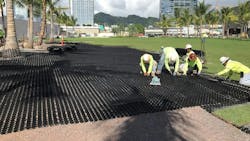The increasing area of impervious surfaces in cities, due to urbanization, has exacerbated urban flooding and stormwater issues. According to the latest reports by the American Society of Civil Engineers (ASCE), stormwater runoff causes $9 billion in infrastructure damages annually and has already polluted nearly 600,000 miles of rivers and streams. Due to this, more than 13 million acres of lakes, reservoirs and ponds are considered impaired. While actions to accelerate stormwater management are crucial, developing expansive preventative infrastructure can be time-consuming and may not reach local communities, where runoff impacts are most acutely felt.
Realizing the need to integrate grassroots-level water management solutions, government agencies at both the federal and local levels are promoting low-impact, green infrastructure development through various federal, state and local initiatives such as the Clean Water State Revolving Fund and St. Louis Park, Minnesota’s ‘Depave SLP.’ As part of the solution, these programs encourage replacing impermeable surfaces with permeable paving systems for effective stormwater management.
Permeable pavements, commonly made from porous asphalt, pervious concrete and plastic, store precipitation and water in a stone reservoir beneath the blocks, that are eventually infiltrated into the groundwater reserves. While effective, asphalt and concrete permeable pavers come with their own set of limitations — they are time-consuming to install and require periodic maintenance.
Plastic porous pavers can address these limitations. Their grid-like structure, with up to 92% void space in select designs, can be filled with grass for a ‘greener’ stormwater management solution. These porous pavers have a high-compressive material strength and readily support vehicular weight. Consequently, they help professionals seeking surface water quality and erosion control integrate an effective low-impact, stormwater solution in walkways, landscapes, parking and fire lanes in their projects.
Increasing green cover for added environmental benefits
When it comes to stormwater management, permeable pavers offer many benefits. The void space in porous paving systems can be filled with sand to create a conducive environment for natural grass and low-maintenance plants to grow. Besides facilitating an aesthetically green landscape, including sand increases the system’s compressive strength and improves drainage by allowing rainwater to easily penetrate the ground, reducing surface runoff.
Supporting vegetation growth using porous paving systems is also important because the root systems will enhance soil stability. It also acts as a natural filter, removing pollutants and environmental toxins from runoff through bioremediation. In this process, pollutant-degrading microorganisms grow with the subsurface elements. As water percolates through the soil, the subsurface system filters out contaminants and cleanses the water before it reaches groundwater. For improved results, professionals can consider using organic soil amendment solutions and fertilizers that supply water and nutrients to promote plant growth.
In addition to water filtration, research by the Lawn Institute highlights that urban lawns facilitate carbon sequestration, absorbing 200 to 1,800 pounds of carbon per acre per year, from the atmosphere and storing it in plants and soil. Another study by the University of California, Davis, found that these grasslands are more resilient carbon sinks than forests because they are impacted less by droughts and wildfires. Facilitating this, grass-filled porous pavers can help mitigate climate change by reducing the overall concentration of greenhouse gases in the atmosphere.
Beyond stormwater challenges, cities experience higher temperatures because the built environment traps heat. This is commonly known as the heat island effect. As an environmental solution, plastic porous pavers help regulate temperatures and mitigate the heat island effect, cooling the surroundings and creating a more comfortable environment. The element-filled void space in a porous paver also absorbs sound waves, helping reduce noise pollution better than its counterpart.
Capitalizing on the benefits of porous pavers, project engineers used this paving system at Victoria Ward Park in Honolulu, Hawaii, to create a green space for the community while bolstering stormwater management. The park, with more than 69,400 square feet of grass-filled porous paving system, is used for special events, parking overflow and emergency vehicles. Additionally, because the chosen porous system rolled out like a carpet and was flexible in its makeup, the project team could integrate the paving system right up to the foot of the existing tree trunks without jeopardizing root health.
Combining maintenance & durability
While porous concrete and asphalt pavers support stormwater management, they can be prone to surface clogging, caused by organic matter and sediment from the surrounding environment. For effectiveness, they require unclogging at least twice a year using an industrial vacuum. Conversely, because porous pavers have a larger void space, they are not prone to clogging and effectively minimize any maintenance requirements.
Additionally, porous asphalt and concrete pavers, while permeable, are not as robust as plastic porous. They tend to be more vulnerable to cracking under heavier loads and susceptible to environmental challenges such as freeze-thaw cycles, which can reduce their longevity and structural integrity.
To sideline some issues with porous asphalt and concrete pavers, manufacturers have engineered porous pavers with compressive strengths up to five times that of concrete. This enables the plastic pavers to withstand the weight and pressure of heavy vehicles, without rutting or uplifting. Their durability extends to extreme weather conditions, making them resilient to temperature fluctuations, heavy rainfall and free-thaw cycles.
Leveraging the proven compressive strength and durability of porous paving, the Pentagon Renovation Program in Arlington utilized the system below helicopter landing pads. This green landscaping covers a nearly 22,000 square-foott area. Its installation not only improves stormwater management but also increases the green cover and mitigates the heat island effect, all contributing to the project’s LEED certification. Professionals responsible for ensuring surface water quality and erosion control can integrate porous pavers in landscapes as well as fire lanes and parking lots to improve water management.
Environmentally conscious solutions
Some manufacturers make porous pavers from 100% recycled plastic, elevating it as a holistic solution for sustainable urban development. The circular approach of using recycled plastic minimizes waste, energy use and carbon emissions. For context, reprocessing resins into plastic requires 88% less energy than producing plastic from raw gas or oil.
Furthermore, at the end of their service life, these pavers can also be recycled, diverting plastic waste from landfills and further reducing environmental impact. To quantify these benefits, recycling one ton of plastic pavers saves nearly 30 cubic yards of landfill space.
Being greener with porous stormwater solutions
Durable and efficient low-impact green infrastructure components are crucial for wider grassroots-level adoption in urban settings. Porous pavers made from recycled plastic exemplify this concept, offering a sustainable alternative with minimal upkeep for stormwater management.








